Oil and fat extraction is a method we'uns will be further developing, so watch this thread.
Cannabinoids and the other terpenes in cannabis, are readily dissolvable in fats and oils, so fats and oils may be used for both extraction and as a menstruum.
When I say fats and oils, I am referring to the vegetable and nut oils, as well as clarified butter. Oils tasty enough that may be ingested with a dropper, mixed with drinks, or used in medibles.
Water solubility varies, but one of the advantages of using oil for extractions, is that they are for the most part non soluble in water, so they don't extract excessive water soluble constitutes, like chlorophyll.
There are practical limits to the potency that can be achieved extracting with oil, because as the oil becomes saturated with cannabis terpenes, they become less concentrated and their solvent action slows down to a crawl, before stopping altogether.
Potency can be ratcheted up somewhat through using the same oil to do multiple extractions of fresh material, but even that has limitations.
A key factor in achieving maximum removal rates and efficiency, is keeping the boundary layer between the un-dissolved resins and the unsaturated oils used for extraction regularly removed. The method that we used in this experiment, was simple, but through periodic stirring.
Sublingual oil tinctures:
Aside for their useful role in extraction, oils and fats may be mixed at any ratios with cannabis terpenes, if you are just mixing them together as oils. Some of them are damn tasty even taken from a dropper, though as the concentration increases, the flavor becomes less fetching and it leaves more of a lingering aftertaste.
Choose an Oil:
We haven't tried them all, but we have tried Almond, Avocado, Butter, Canola, Coconut oil, Grape Seed oil, Olive, Pecan, Sesame, and Walnut oils. They all work well, so they are a good place to start, if you are new to extraction.
Preparing the material:
We first start by drying the trim. For the most floral flavor and the highest amount of lighter terpenes, material that is hung until it reaches the small stem snap stage is best for our purposes.
In our experience, for best flavor and taste, freshest material works best. Older cured material loses the nuances of the floral undertones and just tastes like hash.
That means that the degree of drying and curing is also critical, if your goal is to maintain maximum terpene content. Not that hash has a bad flavor, but it should be a conscious choice.
Choosing material:
Oil from buds is tastier than oil from even sugar trim, because most of the terpenes are produced by the buds, and that is where they are the most plentiful. Tasty is usually not a word used to describe oil from fan leaves or stems, though effective may be.
The material that we used in this experiment, was donated sweet trim from Chocolate and was well dried and cured.
Oils used in this experiment:
We used Ghee (clarified butter), Coconut oil, Grape Seed oil, and Olive oil for the run, because they are commonly available and inexpensive.
Making Ghee:
To make the Ghee, we melted unsalted butter and cooked it at low temperature, until the butter fats separated from the Ghee. We then skimmed off the floating butter fats, and sucked off the Ghee, using a turkey baster, leaving the heavier butter fats in the bottom of the pot.
Most recipes for extraction with butter call for boiling them material in water and butter, but we studiously avoid adding water and our Ghee extraction has only the lightest tinge of green and no chlorophyll flavor.
Here are the three extractions taken out of the refrigerator, where they were stored between cooking and actual pressing. Note that the butter, olive oil, and the coconut extractions have a slightest green tinge, yet none actually had a chlorophyll flavor.
In this experiment, we didn't attempt to reach maximum saturation, but to determine what was reasonable to expect from a single batch. To reach maximum saturation, we would have simply processed more than one batch of fresh material through the oil.
What we did, was fill four jars 3/4 full of the trim and then added enough oil to cover it, stirred it thoroughly, and then added another inch of oil.
We then lightly capped the jars and set them in pot of hot water and simmered it on low for six hours, uncapping and stirring thoroughly a couple of times an hour.
At the end of six hours, we removed the jars from the hot water and set them aside to cool. The next day, we cooked them two more hours, stirring regularly, and the third day we cooked them another six hours, for 14 hours total, with three heat cycles.
Lightly capping means snug enough to allow some pressure to build, but loose enough to vent off anything excessive. Since we used cured material and didn't add water, there were little in the way of volatiles to boil off and produce pressure.
I left the lid off the boiling pot, so as to not force steam into the jar head space.
For pressing, we warmed the oils and ghee up by placing them in boiling water, this time with the lids on tight and the lid on the pot,
Next we cut up some rags from some surplus drape material, with approximately a 160/200 thread count, and draped it over a restaurant sized potato ricer that we scored at Hongs Restaurant Supply in Portland. By pressing it down into the potato ricer, it formed a pocket that holds approximately a quart of plant material.
Folding the cloth over and pressing it, produced a pristine clear oil, which was tasty enough to dropper.
The most flavorful, was the ghee, and possibly the fastest to uptake and produce an effect. Alas, after just testing just enough of each of them to determine their flavors, I needed a nap, so the next phase of this project, is to titrate for potency and effect, as well as flavor, using volunteer test panels.
We also will experiment with different ways to use the oils in medibles, so I will update this post as they occur:
Copied from:
http://skunkpharmresearch.com/extracting-with-oils-and-fats/
Cannabinoids and the other terpenes in cannabis, are readily dissolvable in fats and oils, so fats and oils may be used for both extraction and as a menstruum.
When I say fats and oils, I am referring to the vegetable and nut oils, as well as clarified butter. Oils tasty enough that may be ingested with a dropper, mixed with drinks, or used in medibles.
Water solubility varies, but one of the advantages of using oil for extractions, is that they are for the most part non soluble in water, so they don't extract excessive water soluble constitutes, like chlorophyll.
There are practical limits to the potency that can be achieved extracting with oil, because as the oil becomes saturated with cannabis terpenes, they become less concentrated and their solvent action slows down to a crawl, before stopping altogether.
Potency can be ratcheted up somewhat through using the same oil to do multiple extractions of fresh material, but even that has limitations.
A key factor in achieving maximum removal rates and efficiency, is keeping the boundary layer between the un-dissolved resins and the unsaturated oils used for extraction regularly removed. The method that we used in this experiment, was simple, but through periodic stirring.
Sublingual oil tinctures:
Aside for their useful role in extraction, oils and fats may be mixed at any ratios with cannabis terpenes, if you are just mixing them together as oils. Some of them are damn tasty even taken from a dropper, though as the concentration increases, the flavor becomes less fetching and it leaves more of a lingering aftertaste.
Choose an Oil:
We haven't tried them all, but we have tried Almond, Avocado, Butter, Canola, Coconut oil, Grape Seed oil, Olive, Pecan, Sesame, and Walnut oils. They all work well, so they are a good place to start, if you are new to extraction.
Preparing the material:
We first start by drying the trim. For the most floral flavor and the highest amount of lighter terpenes, material that is hung until it reaches the small stem snap stage is best for our purposes.
In our experience, for best flavor and taste, freshest material works best. Older cured material loses the nuances of the floral undertones and just tastes like hash.
That means that the degree of drying and curing is also critical, if your goal is to maintain maximum terpene content. Not that hash has a bad flavor, but it should be a conscious choice.
Choosing material:
Oil from buds is tastier than oil from even sugar trim, because most of the terpenes are produced by the buds, and that is where they are the most plentiful. Tasty is usually not a word used to describe oil from fan leaves or stems, though effective may be.
The material that we used in this experiment, was donated sweet trim from Chocolate and was well dried and cured.
Oils used in this experiment:
We used Ghee (clarified butter), Coconut oil, Grape Seed oil, and Olive oil for the run, because they are commonly available and inexpensive.
Making Ghee:
To make the Ghee, we melted unsalted butter and cooked it at low temperature, until the butter fats separated from the Ghee. We then skimmed off the floating butter fats, and sucked off the Ghee, using a turkey baster, leaving the heavier butter fats in the bottom of the pot.
Most recipes for extraction with butter call for boiling them material in water and butter, but we studiously avoid adding water and our Ghee extraction has only the lightest tinge of green and no chlorophyll flavor.
Here are the three extractions taken out of the refrigerator, where they were stored between cooking and actual pressing. Note that the butter, olive oil, and the coconut extractions have a slightest green tinge, yet none actually had a chlorophyll flavor.
In this experiment, we didn't attempt to reach maximum saturation, but to determine what was reasonable to expect from a single batch. To reach maximum saturation, we would have simply processed more than one batch of fresh material through the oil.
What we did, was fill four jars 3/4 full of the trim and then added enough oil to cover it, stirred it thoroughly, and then added another inch of oil.
We then lightly capped the jars and set them in pot of hot water and simmered it on low for six hours, uncapping and stirring thoroughly a couple of times an hour.
At the end of six hours, we removed the jars from the hot water and set them aside to cool. The next day, we cooked them two more hours, stirring regularly, and the third day we cooked them another six hours, for 14 hours total, with three heat cycles.
Lightly capping means snug enough to allow some pressure to build, but loose enough to vent off anything excessive. Since we used cured material and didn't add water, there were little in the way of volatiles to boil off and produce pressure.
I left the lid off the boiling pot, so as to not force steam into the jar head space.
For pressing, we warmed the oils and ghee up by placing them in boiling water, this time with the lids on tight and the lid on the pot,
Next we cut up some rags from some surplus drape material, with approximately a 160/200 thread count, and draped it over a restaurant sized potato ricer that we scored at Hongs Restaurant Supply in Portland. By pressing it down into the potato ricer, it formed a pocket that holds approximately a quart of plant material.
Folding the cloth over and pressing it, produced a pristine clear oil, which was tasty enough to dropper.
The most flavorful, was the ghee, and possibly the fastest to uptake and produce an effect. Alas, after just testing just enough of each of them to determine their flavors, I needed a nap, so the next phase of this project, is to titrate for potency and effect, as well as flavor, using volunteer test panels.
We also will experiment with different ways to use the oils in medibles, so I will update this post as they occur:
Copied from:
http://skunkpharmresearch.com/extracting-with-oils-and-fats/
Attachments
-
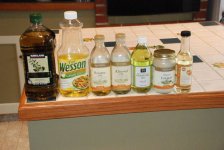 Oils-1-1.jpg50.4 KB · Views: 26
Oils-1-1.jpg50.4 KB · Views: 26 -
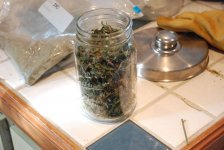 Leaf material for extraction-1-1.jpg52.6 KB · Views: 30
Leaf material for extraction-1-1.jpg52.6 KB · Views: 30 -
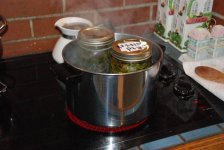 Boiling jars of oil-1-1.jpg49.8 KB · Views: 27
Boiling jars of oil-1-1.jpg49.8 KB · Views: 27 -
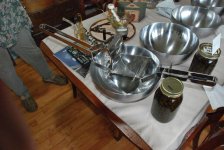 Commercial ricer-1-1.jpg64.3 KB · Views: 25
Commercial ricer-1-1.jpg64.3 KB · Views: 25 -
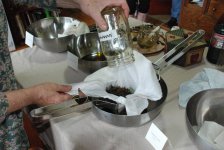 Dumping jars-1-1.jpg58.4 KB · Views: 27
Dumping jars-1-1.jpg58.4 KB · Views: 27 -
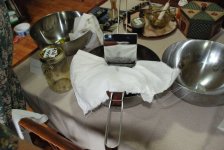 Fold over cloth-1-1.jpg56.5 KB · Views: 27
Fold over cloth-1-1.jpg56.5 KB · Views: 27 -
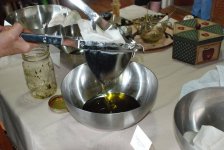 Pressing-1-1.jpg54.2 KB · Views: 26
Pressing-1-1.jpg54.2 KB · Views: 26 -
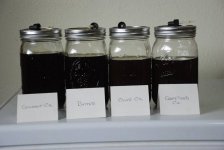 Extracted oils-1-1.jpg34.7 KB · Views: 28
Extracted oils-1-1.jpg34.7 KB · Views: 28

 . Im new to trying edibles,oils,cooking with cannabis in general. I will be keeping an eye on this for new and updated info. fh
. Im new to trying edibles,oils,cooking with cannabis in general. I will be keeping an eye on this for new and updated info. fh


